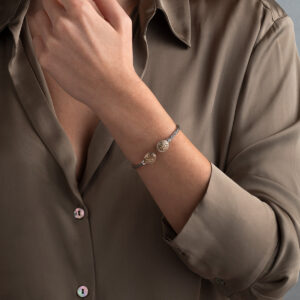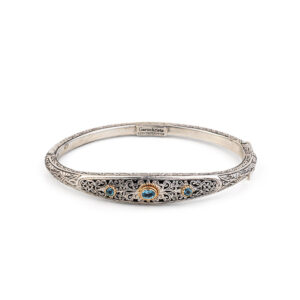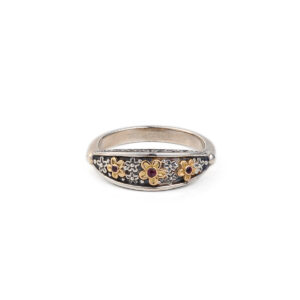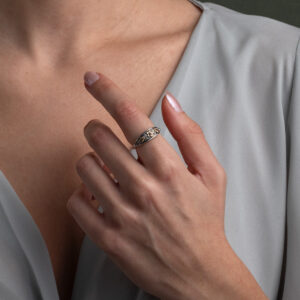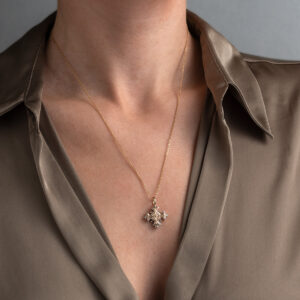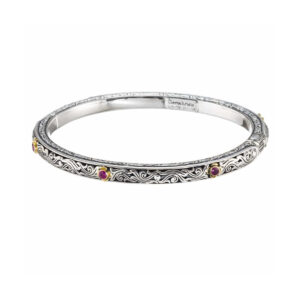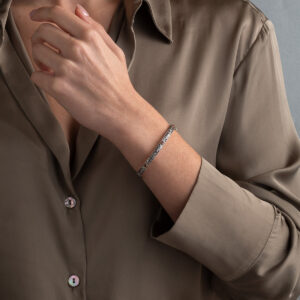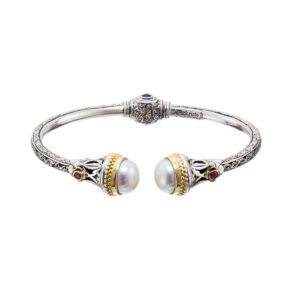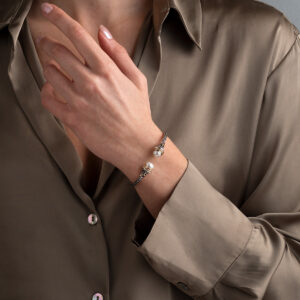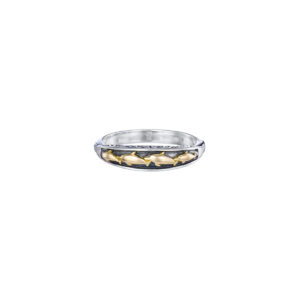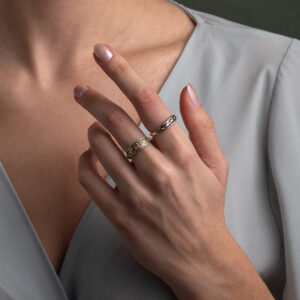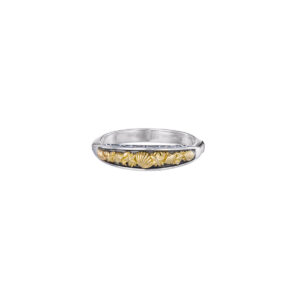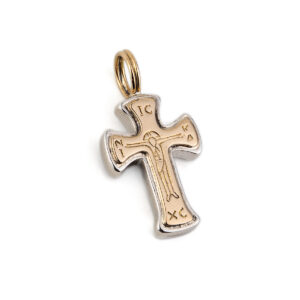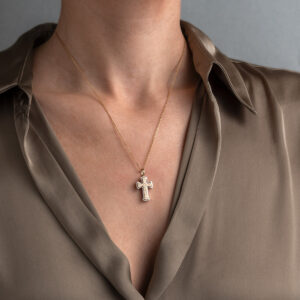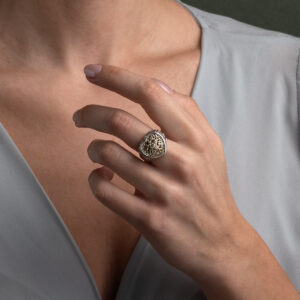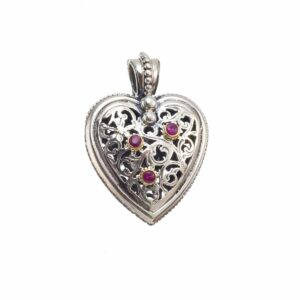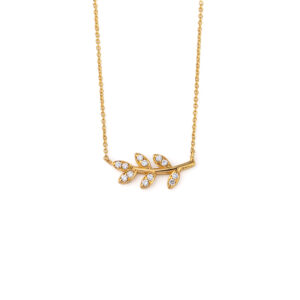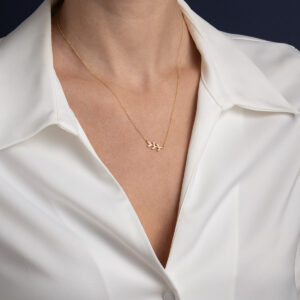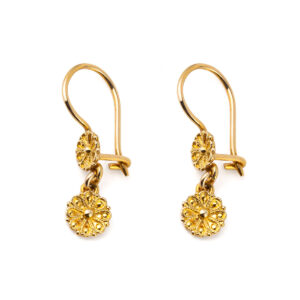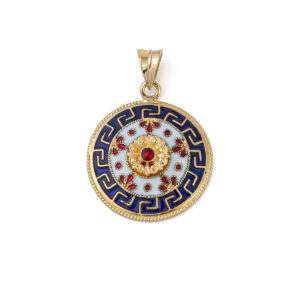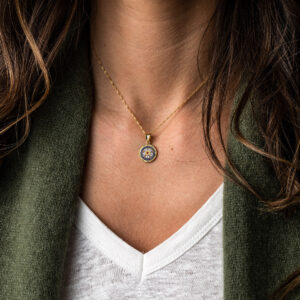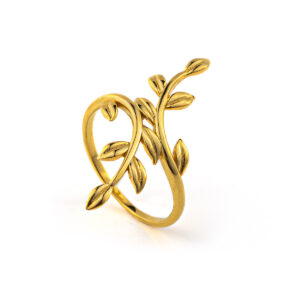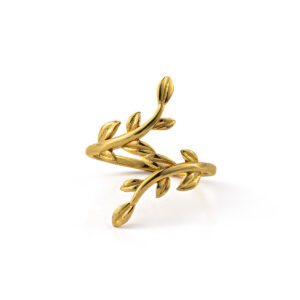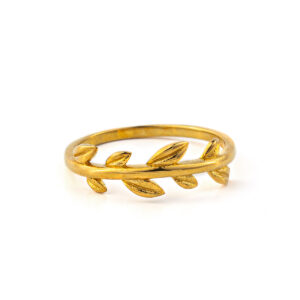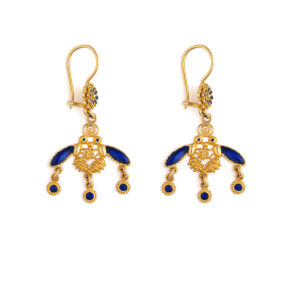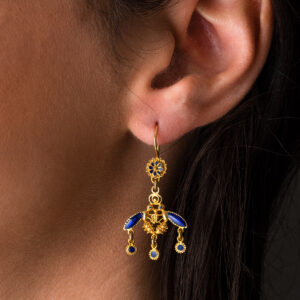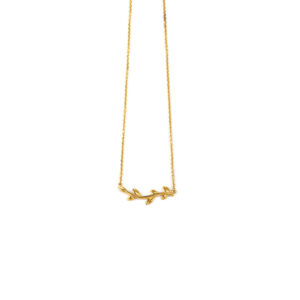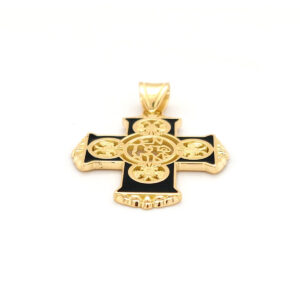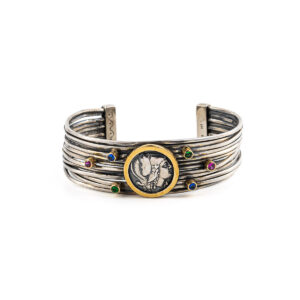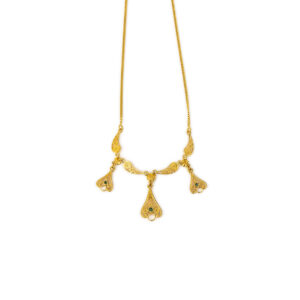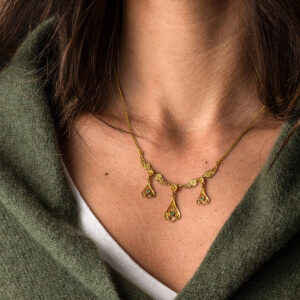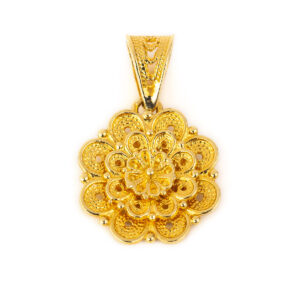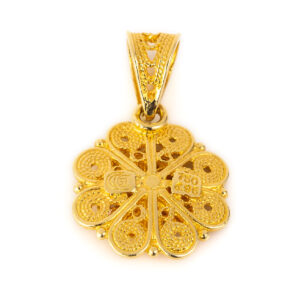Gerochristo – Mediterranean Bracelet in 18K Gold and Sterling Silver with Ruby
637,00€Bracelet in Sterling Silver and 18K Gold with with Ruby.
Handcrafted jewelry made in Greece.
Mediterranean Collection by Gerochristo
Gerochristo – Mediterranean Bracelet in 18K Gold and Sterling Silver with Blue Topaz
732,00€Bracelet in Sterling Silver and 18K Gold with blue topaz.
Handcrafted jewelry made in Greece.
Nefeli Collection by Gerochristo
Gerochristo – Anthemis Ring in Sterling silver and 18K Yellow Gold with Rubies
249,00€Ring in 18K Gold and Sterling silver.
Handcrafted jewelry made in Greece.
Anthemis Collection by Gerochristo
Gerochristo – Anthemis Ring in Sterling silver and 18K solid Yellow Gold
175,00€Ring in 18K Gold and Sterling silver.
Handcrafted jewelry made in Greece.
Anthemis Collection by Gerochristo
Gerochristo – Byzantine Cross in 18K Gold and Sterling Silver
332,00€Tiny cross in 18K solid Yellow Gold and sterling silver.
Handcrafted jewelry made in Greece.
Faith Collection by Gerochristo
Gerochristo – Bracelet in Sterling Silver and 18K Gold
595,00€Bracelet in Sterling Silver and 18K Gold with rubies.
Handcrafted jewelry made in Greece.
Nefeli Collection by Gerochristo
Gerochristo – Eva bracelet in 18K Gold and Sterling silver
935,00€Bracelet in 18K Gold, sterling silver and semi precious stones.
Handcrafted jewelry made in Greece.
Santorini Collection by Gerochristo
Gerochristo – Santorini Bracelet in 18K Gold and Sterling Silver
1.085,00€Bracelet in 18K Gold, sterling silver, rubies and freshwater pearls.
Handcrafted jewelry made in Greece.
Santorini Collection by Gerochristo
Gerochristo – Dolphins ring in 18K Gold and Sterling Silver
179,00€Ring with dolphins design in 18K solid Yellow Gold and Sterling Silver.
Handcrafted jewelry made in Greece.
Santorini Collection by Gerochristo
Gerochristo – Shells and starfish ring in 18K Gold and Sterling Silver
179,00€Ring with shells and startfish design in 18K solid Yellow Gold and Sterling Silver.
Handcrafted jewelry made in Greece.
Santorini Collection by Gerochristo
Gerochristo – Aretousa Ring in 18K Gold and Sterling Silver
203,00€Ring in 18K Gold and Sterling silver.
Handcrafted jewelry made in Greece.
Aretousa Collection by Gerochristo
Gerochristo – Classic Cross in Sterling Silver and 18K Gold with ruby
123,00€Cross in Sterling Silver with details in 18K solid Yellow Gold and ruby.
Handcrafted jewelry made in Greece.
Chain sold separately.
Faith Collection by Gerochristo
Gerochristo – Aretousa Cross in 18K Gold and Sterling silver
294,00€Cross in 18K solid Yellow Gold, sterling silver and ruby.
Handcrafted jewelry made in Greece.
Chain sold separately.
Aretousa Collection by Gerochristo
Gerochristo – Tiny Byzantine cross in 18K Gold and Sterling Silver
311,00€IC XC NI KA tiny cross in 18K solid Yellow Gold and sterling silver.
Chain sold separately
Handcrafted jewelry made in Greece.
Faith Collection by Gerochristo
Gerochristo – Classic Cross in 18K Gold and Sterling Silver with ruby
482,00€Cross in 18K solid Yellow Gold and Sterling Silver with ruby.
Cross dimension with the bale 2.6mm x 1.7mm – 1.02″ x 0.66″
Handcrafted jewelry made in Greece.
Faith Collection by Gerochristo
Gerochristo – Maltese Patmos cross in 18K Gold & Sterling Silver
483,00€Cross in 18K solid Yellow Gold and sterling silver.
Handcrafted jewelry made in Greece.
Patmos Collection by Gerochristo
Gerochristo – Mediterranean heart Ring in 18K Gold and Sterling Silver
434,00€Embrace elegance with the Gerochristo Mediterranean Heart Ring, a stunning fusion of 18K gold and sterling silver. This exquisite ring, featuring a striking heart motif, symbolizes love and is perfect for those who appreciate the finer things in life. The heart, crafted in radiant 18K gold, sits beautifully on a bed of intricately designed sterling silver, reflecting the charm of the Mediterranean.
The ring’s band, made from high-quality sterling silver, boasts elegant details, enhancing its overall allure. The contrast of the warm gold heart against the cool silver band adds a touch of sophistication, making this ring a versatile piece for any outfit.
Ideal for special occasions, as a gift of love, or as a luxurious treat to yourself, the Gerochristo Mediterranean Heart Ring is more than just a piece of jewelry. It symbolizes enduring style and timeless elegance, promising a cherished addition to any collection.
Ring in 18K solid Yellow Gold and sterling silver. Handcrafted jewelry made in Greece. The sterling silver band, adorned with delicate, handcrafted patterns, whispers tales of ancient romance and enduring beauty. The harmonious blend of gold and silver is a meeting of metals and a fusion of stories, dreams, and passions. Perfect for those who hold the Mediterranean close to their heart, this ring is more than a jewel; it’s a poetic embrace, a keepsake of love that resonates with the rhythm of the waves and the sun’s warmth.
Gerochristo Rings are famous for their unique design. All rings are a circle without end, echoing the eternal nature of love, the unbroken promise between two hearts. The perfect circle aligns with its symbolism – a never-ending loop reflecting infinite love and unyielding commitment. Rings are a reminder of that boundless love, a physical embodiment of the depth and magnitude of feelings that words can only begin to describe. In its simple elegance lies the promise of forever, a vow as deep and vast as the sea.
Handcrafted jewelry made in Greece.
Explore Valentine Collection by Gerochristo
Gerochristo – Garden Shadows Heart pendant in 18K Gold and Sterling Silver with rubies
487,00€Heart pendant, decorated with filigree, handcrafted with the finest attention to detail.
Embrace elegance with the Garden Shadows medium Heart pendant in 18K Gold and Sterling Silver with rubies. This exquisite pendant, featuring a striking heart motif, symbolizes love and is perfect for those who appreciate the finer things in life.
The pendant boasts elegant details, enhancing its overall allure.
Ideal for special occasions, as a gift of love.
Handcrafted jewelry made in Greece.
Explore Valentine Collection by Gerochristo
The chain shown is not included.
Olive Leaf Necklace with Zircon – 18K Solid Yellow Gold
745,00€Necklace inspired by the olive leaf symbol.
Made of 18k gold with zircon.
The olive wreath also known as kotinos was the prize for the winner at the ancient Olympic Games. It was an olive branch, of the wild- olive tree that grew at Olympia, intertwined to form a circle or a horse-shoe. According to Pausanias it was introduced by Heracles as a prize for the running race winner to honour his father Zeus. In the ancient Olympic Games there were no gold, silver, or bronze medals. There was only one winner per event, crowned with an olive wreath made of wild-olive leaves from a sacred tree near the temple of Zeus at Olympia. Olive wreaths were given out during the 2004 Summer Olympics in Athens in honor of the ancient tradition, because the games were being held in Greece.
Handmade item.
Explore Olive Collection
18K Gold Byzantine Rosette Earrings
465,00€Byzantine earrings with the shape of a flower rosette.
Handmade with great attention to detail. Inspired by Byzantine art.
Made in 18k gold.
Handmade item.
Explore Byzantine Collection
Rosette flower
The rosette (rose) is a timeless jewel, symbol, and amulet. The origin of the term is the Greek word for rose – rodon (ρόδον). Its use began in the Mycenaean era and continues as far as the 2nd millennium BC. The Mycenaean Rosette is a motif that was widespread throughout Mesopotamia, Egypt, Greece, and other ancient civilizations. It is inspired by a Mycenaean rosette bead, found at Mycenae, dated to 1400-1300 B.C. The rosette was used extensively in ancient Greek Mycenaean jewels, in architecture, pottery, and sculptures from 1500 BC. Mycenaean rosettes usually had 6 or 8 or 12 leaves, and sixteen leaves during the Macedonian Dynasty. Such details as the rodax shape and the number of leaves tend to vary with the era or beliefs. The rosettes were used to decorate the clothes, belts, and wreaths of the Kings. The number of leaves had a symbolic character each time. The four elements of nature (wind, earth, fire, water), the seven wonders of the ancient world or the twelve gods of ancient Greeks, and the world domination and radiance of the Kings of Macedonia. They were signs of beauty, purity, eugenics, worship, and power. Rosette or Rodax was probably the most popular and favorite decorative element in Mycenaean era, classical antiquity and Byzantine times.
18k Solid Gold Greek Key Pendant with Blue enamel
1.275,00€Ancient Greek Round Pendant with blue enamel. The back side of the pendant has no decoration.
Design inspired by the incredible beauty of historical tradition.
Made in 18k yellow gold.
The chain shown is our 14K Gold Twisted Chain in Length 40cm (not included).
Handmade item.
Explore Byzantine Collection
18K Gold Filigree Byzantine Cross
530,00€Byzantine Cross embellished with a fine filigree.
Handmade with great attention to detail. Inspired by Byzantine art.
Made in 18k gold
Filigree is a delicate kind of jewellery metalwork, made with tiny beads or twisted threads, or both in combination, soldered together or to the surface of an object of the same metal and arranged in artistic motifs. The art of filigree dates back to ancient history. The first of the found jewelry in this technique has been found in Mesopotamia and dates to thousands of years BC. In the ancient world and particularly in Asia Minor, this art grew at the highest level.
Olive Leaf Branch Ring – 18K Solid Yellow Gold
630,00€Ring inspired by the olive leaf symbol.
Made of 18k gold.
The olive wreath also known as kotinos was the prize for the winner at the ancient Olympic Games. It was an olive branch, of the wild- olive tree that grew at Olympia, intertwined to form a circle or a horse-shoe. According to Pausanias it was introduced by Heracles as a prize for the running race winner to honour his father Zeus. In the ancient Olympic Games there were no gold, silver, or bronze medals. There was only one winner per event, crowned with an olive wreath made of wild-olive leaves from a sacred tree near the temple of Zeus at Olympia. Olive wreaths were given out during the 2004 Summer Olympics in Athens in honor of the ancient tradition, because the games were being held in Greece.
Olive Branch Ring – 18K Solid Yellow Gold
567,00€Ring inspired by the olive leaf symbol.
Made of 18k gold.
The olive wreath also known as kotinos was the prize for the winner at the ancient Olympic Games. It was an olive branch, of the wild- olive tree that grew at Olympia, intertwined to form a circle or a horse-shoe. According to Pausanias it was introduced by Heracles as a prize for the running race winner to honour his father Zeus. In the ancient Olympic Games there were no gold, silver, or bronze medals. There was only one winner per event, crowned with an olive wreath made of wild-olive leaves from a sacred tree near the temple of Zeus at Olympia. Olive wreaths were given out during the 2004 Summer Olympics in Athens in honor of the ancient tradition because the games were being held in Greece.
Leaf Ring – 18K Solid Yellow Gold
460,00€Ring inspired by the olive leaf symbol.
Made of 18k gold.
The olive wreath also known as kotinos was the prize for the winner at the ancient Olympic Games. It was an olive branch, of the wild- olive tree that grew at Olympia, intertwined to form a circle or a horse-shoe. According to Pausanias it was introduced by Heracles as a prize for the running race winner to honour his father Zeus. In the ancient Olympic Games there were no gold, silver, or bronze medals. There was only one winner per event, crowned with an olive wreath made of wild-olive leaves from a sacred tree near the temple of Zeus at Olympia. Olive wreaths were given out during the 2004 Summer Olympics in Athens in honor of the ancient tradition because the games were being held in Greece.
Minoan Malia Bees Dangle Earrings – 18K Solid Yellow Gold and enamel
945,00€Dangle earrings inspired by the ancient Minoan Greek Malia bees pendant.
Made of 18K Gold.
Handmade item.
The Minoan Bees Pendant, one of the most famous Minoan artworks, was discovered in the Old Palace cemetery at Chrysolakkos, outside the palace of Malia, the third largest and most significant known Minoan palace after Knossos and Phaistos. Chryssolakkos means the “Pit of gold” because of the many precious objects that were found there. The famous pendant dates back to the Bronze Age, (1800 BC) and it’s a stunning, very detailed representation of two bees or wasps storing away a drop of honey in their honeycomb. This pendant is one of the most famous exhibits in the wonderfully Heraklion archeological museum.
As in all handmade items, there may be small differences in weight and dimensions and this is what makes them unique and precious.
Leaf Necklace – 18k Yellow Gold
460,00€Made of 18K gold.
A necklace inspired by the olive branch, a symbol of peace, abundance and achievement.
Handmade item.
En Touto Nika Cross – 18K Solid Gold with Turquoise Enamel
1.386,00€A unique golden cross with turquoise enamel.At the center of the cross there is the inscription “En Touto Nika”, which is literally meaning “in this, conquer”.
Α double headed eagle symbol decorates every edge of the cross.
Handmade with great attention to detail. Inspired by Byzantine Art.
Made of 18k gold. As in all handmade items there may be small differences in weight and dimensions and this is what makes them unique and precious.
Goddess Athena Cuff Bracelet – 18K Gold and 925 Sterling Silver
920,00€Α beautiful and timeless bracelet inspired by an ancient Greek tetradrachm. This coin is one of the most popular ancient Greek coins which illustrates the portrait of Goddess Athena.
Made in 18k gold and 925 sterling silver.
Handmade item. As in all handmade items, there may be small differences in weight and dimensions and this is what makes them unique and precious.
Goddess Athena- Athenian silver tetradrachm
Dracma was the currency used in Greece during several periods in its history.
The tetradrachm was an Ancient Greek silver coin equivalent to fourdrachmae in Athens it replaced the earlier “heraldic” type of didrachms and it was in wide circulation from ca. 510 to ca. 38 BC.
This coin belongs to the so-called “new style Athenian coins” minted between 166 and 64 B.C. and is considered one of the most popular ancient Greek coins that illustrate the portrait of Goddess Athena. Athena is an ancient Greek goddess associated with wisdom, handicraft, and warfare.
Athena was regarded as the patron and protectress of various cities across Greece, particularly the city of Athens, from which she most likely received her name. She’s usually shown in art wearing a helmet and holding a spear. Her major symbols include owls, olive trees, and snakes. Her temples were located atop the fortified Acropolis in the central part of the city. The Parthenon on the Athenian Acropolis is dedicated to her, along with numerous other temples and monuments. Her main festival in Athens was the Panathenaia, which was celebrated in midsummer and was the most important festival on the Athenian calendar.
In the classical Olympian pantheon, Athena was regarded as the favorite daughter of Zeus. The owl traditionally accompanies Athena. Because of such association, the owl has been used as a symbol of knowledge and wisdom. The inscriptions contain the city’s “national” appellation (“ΑΘΕ», i.e. “of the Athenians”).
18K Gold Byzantine Filigree Emerald Necklace
1.386,00€Byzantine necklace is embellished with a fine filigree, three rosettes flowers and emeralds.
Handmade with the great attention to detail. Inspired by Byzantine art.
Made in 18k gold
Filigree is a delicate kind of jewellery metalwork, made with tiny beads or twisted threads, or both in combination, soldered together or to the surface of an object of the same metal and arranged in artistic motifs. The art of filigree dates back to ancient history. The first of the found jewelry in this technique have been found in Mesopotamia and dates to thousands of years BC. In the ancient world and particularly in Asia Minor, this art grew were at the highest level.
Rosette flower
The rosette (rose) is a timeless jewel, symbol and amulet. The origin of the term is the Greek word for rose – rodon (ρόδον). Its use began in the Mycenaean era and continues as far as the 2nd millennia BC. The Mycenaean Rosette is a motif that was widespread throughout Mesopotamia, Egypt, Greece and other ancient civilizations. It is inspired by a Mycenaean rosette bead, found at Mycenae, dated to 1400-1300 B.C. The rosette were used extensively in ancient Greek Mycenaean jewels, in architecture, pottery and in sculptures from 1500 BC. Mycenaean rosettes usually had 6 or 8 or 12 leaves, and sixteen leaves during the Macedonian Dynasty. Such details as the rodax shape and the number of leaves tend to vary with the era or beliefs. The rosettes were used to decorate the cloths, the belts and wreaths of the Kings. The number of leaves had a symbolic character each time. The four elements of nature (wind, earth, fire, water), the seven wonders of the ancient world or the twelve gods of ancient Greeks and the world domination and radiance of the Kings of Macedonia. They were signs of beauty, purity, eugenics, worship and power. Rosette or Rodax was probably the most popular and favorite decorative element in Mycenaean era, classical antiquity and Byzantine times.
18K Gold Byzantine Filigree Sapphire Necklace
1.474,00€Byzantine necklace embellished with fine filigree and three rosettes flowers which are decorated with a sapphire
Handmade with great attention to detail. Inspired by Byzantine art.
Made in 18k gold
Filigree is a delicate kind of jewellery metalwork, made with tiny beads or twisted threads, or both in combination, soldered together or to the surface of an object of the same metal and arranged in artistic motifs. The art of filigree dates back to ancient history. The first of the found jewelry in this technique has been found in Mesopotamia and dates to thousands of years BC. In the ancient world and particularly in Asia Minor, this art grew at the highest level.
Rosette flower
The rosette (rose) is a timeless jewel, symbol and amulet. The origin of the term is the Greek word for rose – rodon (ρόδον). Its use began in the Mycenaean era and continues as far as the 2nd millennia BC. The Mycenaean Rosette is a motif that was widespread throughout Mesopotamia, Egypt, Greece and other ancient civilizations. It is inspired by a Mycenaean rosette bead, found at Mycenae, dated to 1400-1300 B.C. The rosette was used extensively in ancient Greek Mycenaean jewels, in architecture, pottery and in sculptures from 1500 BC. Mycenaean rosettes usually had 6 or 8 or 12 leaves, and sixteen leaves during the Macedonian Dynasty. Such details as the rodax shape and the number of leaves tend to vary with the era or beliefs. The rosettes were used to decorate the cloths, the belts and wreaths of the Kings. The number of leaves had a symbolic character each time. The four elements of nature (wind, earth, fire, water), the seven wonders of the ancient world or the twelve gods of ancient Greeks and the world domination and radiance of the Kings of Macedonia. They were signs of beauty, purity, eugenics, worship and power. Rosette or Rodax was probably the most popular and favorite decorative element in Mycenaean era, classical antiquity and Byzantine times.
18K Gold Filigree Byzantine Rosette Pendant
572,00€Byzantine pendant which have the shape of a flower rosette.
This pendant is embellished with a fine filigree and granules of precious metal.
Handmade with great attention to detail. Inspired by Byzantine art.
Made in 18k gold
Rosette flower
The rosette (rose) is a timeless jewel, symbol and amulet. The origin of the term is the Greek word for rose – rodon (ρόδον). Its use began in the Mycenaean era and continues as far as the 2nd millennia BC. The Mycenaean Rosette is a motif that was widespread throughout Mesopotamia, Egypt, Greece and other ancient civilizations. It is inspired by a Mycenaean rosette bead, found at Mycenae, dated to 1400-1300 B.C. The rosette was used extensively in ancient Greek Mycenaean jewels, in architecture, pottery and in sculptures from 1500 BC. Mycenaean rosettes usually had 6 or 8 or 12 leaves, and sixteen leaves during the Macedonian Dynasty. Such details as the rodax shape and the number of leaves tend to vary with the era or beliefs. The rosettes were used to decorate the cloths, belts and wreaths of the Kings. The number of leaves had a symbolic character each time. The four elements of nature (wind, earth, fire, water), the seven wonders of the ancient world or the twelve gods of ancient Greeks and the world domination and radiance of the Kings of Macedonia. They were signs of beauty, purity, eugenics, worship and power. Rosette or Rodax was probably the most popular and favorite decorative element in Mycenaean era, classical antiquity and Byzantine times.
Granulation (from Latin: granum = “grain”) is a jewellery technique whereby a surface of a jewel is covered with small spheres or granules of precious metal. The technique is thought to have its origins in Mesopotamia about 5,000 years ago.
Filigree is a delicate kind of jewellery metalwork, made with tiny beads or twisted threads, or both in combination, soldered together or to the surface of an object of the same metal and arranged in artistic motifs. The art of filigree dates back to ancient history. The first of the found jewelry in this technique has been found in Mesopotamia and dates to thousands of years BC. In the ancient world and particularly in Asia Minor, this art grew at the highest level.


